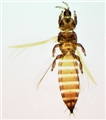Chirothrips falsus
Recognition data
Distinguishing features
Female fully winged, male effectively wingless with wing lobe minute. Body, antennae and legs brown, tarsi slightly paler, forewings light brown. Head small, weakly prolonged in front of eyes; 2 pairs of ocellar setae present, pair III anterolateral to fore ocellus. Antennae 8-segmented; segment II weakly asymmetric with external margin broadly rounded; segments III � IV with sensorium simple and stout. Pronotum trapezoidal, 2 pairs of prominent posteroangular setae. Metanotum reticulate, sculpture forming arches around posterior midpoint; median setae not at anterior margin, smaller than lateral pair. Forewings pointed; first vein distal half with 2 setae, second vein with 2 to 4 setae. Abdominal tergites medially with transverse sculpture lines; posteromarginal craspedum with weak lobes; ovipositor serrate. Posterior margin of sternites with tubercles. Male with no ocelli; sternites III-VII with small circular glandular area.
Related and similar species
C. falsus and C. simplex are here considered the same species, although zur Strassen (1967) interpreted the variation as representing two species. Currently there are 50 species worldwide in the genus Chirothrips. The key to species provided by zur Strassen (1960) treated the genus in a broad sense, whereas Bhatti (1990) created six new genera for these species, including Arorathrips for several species from the New World that have the mesothoracic endofurca reduced.
Taxonomic data
Current valid name
Chirothrips falsus Priesner
Original name and synonyms
Chirothrips falsus Priesner, 1925: 312
Chirothrips simplex Hood, 1927: 128
Family placement
Thripidae, Thripinae
Biological data
Life history
Breeding and pupating within individual florets of Poaceae.
Host plants
Various Poaceae species with no clear specificity.
Tospoviruses vectored
None
Crop damage
None recorded.
Distribution data
Area of origin
South western USA
Distribution
California, Mexico, Arizona, Colorado, New Mexico, Texas, Iowa, North Dakota, Illinois. The record from Europe by Bailey (1957) is not supported (zur Strassen, 2003).






